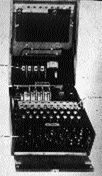
The Enigma cipher machine |
Publicly, he sponsored the entry into Britain of a
young German Jewish refugee. Secretly, he worked part-time for the
British cryptanalytic department, the so-called Government Code and
Cypher School. His appointment marked the first scientific input
into a hitherto arts-based department. That revolution was caused by
the failure of pre-scientific methods to penetrate the mechanical
Enigma cipher used by Germany. No significant progress was made,
however, until the gift of vital ideas and information in July 1939
from Poland, where mathematicians had been employed on the problem
much earlier. |
| Upon British declaration of war on 3 September, Turing
took up full-time work at the wartime cryptanalytic headquarters,
Bletchley Park. The Polish work was limited as it depended upon the
very particular way the Germans had been using the Enigma. One of
their ideas was embodied in a machine called a Bomba. The way
forward lay in Turing's generalisation of the Polish Bombe into a
far more powerful device, capable of breaking any Enigma message
where a small portion of plaintext could be guessed correctly.
Another Cambridge mathematican, W. G. Welchman, made an important
contribution, but the critical factor was Turing's brilliant
mechanisation of subtle logical deductions.
From late 1940 onwards, the Turing-Welchman Bombe made reading of
Luftwaffe signals routine. In contrast, the more complex Enigma
methods used in German Naval communications were generally regarded
as unbreakable. Happy to work alone on a problem that defeated
others, Turing cracked the system at the end of 1939, but it
required the capture of further material by the Navy, and the
development of sophisticated statistical processes, before regular
decryption could begin in mid-1941. Turing's section 'Hut 8', which
deciphered Naval and in particular U-boat messages, then became a
key unit at Bletchley Park. By the end of 1941, as the United States
entered the war, the battle of the Atlantic was moving towards
Allied advantage. On 1 February 1942, the Atlantic U-boat Enigma
machine was given an extra complication and this advantage was
suddenly wiped out: nothing could be decoded and catastrophe loomed.
Besides illustrating the always razor-edge state of the war of
wits, this crisis brought about a new ingredient in Alan Turing's
experience: electronic technology made its first appearance at
Bletchley Park as telephone engineers were pressed into an effort to
gain ever higher speeds of mechanical working. As it turned out,
however, the electronic engineers found themselves called upon to
mechanize the breaking of the 'Fish' material: messages enciphered
on the quite different system used for Hitler's strategic
communications. Here again Turing's statistical ideas underlay the
methods employed, though it was M. H. A. Newman who played the
organising role. The conjunction of Turing's thoughts with the
practicality of large-scale electronic machinery, arising from this
technical U-boat Enigma change, came to have momentous consequences.
|
